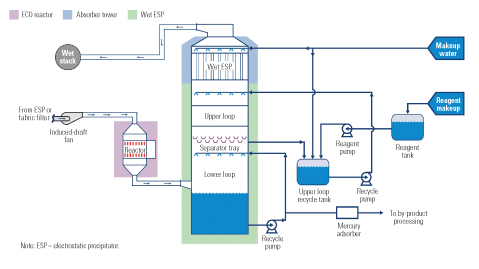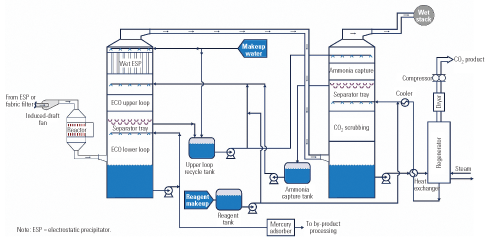R.E. Burger Plant, Shadyside, Ohio
Coal is still king in the realm of power generation, but the palace is under siege by new environmental rules with bigger teeth. Emerging air emissions regulations—in the form of the Clean Air Interstate Rule (CAIR), the Clean Air Mercury Rule (CAMR), and a patchwork of state rules—make plant environmental upgrades more expensive and take a bigger bite out of the industry’s investment dollar.
To be sure, the return on that investment will be a tangible improvement in the air we breathe. The gains in air quality attributable to the installation and upgrades of air quality control systems (AQCS) at power plants since passage of the original Clean Air Act in 1970 are certainly remarkable. But the days of inexpensive retrofits to capture "low-hanging fruit" are long gone. We’ll leave the discussion of "How low can you go?" for another time.
Most AQCS designs are evolutionary, and at some point all of the technologies on which they are based have been mixed and matched at some plant in the U.S. Removing specific constituents of the exhaust gas stream—first NOx, SO2, and particulate matter (PM), and now mercury (Hg)—is so dependent on a plant’s design, location, and fuel type that dozens of alternative reduction approaches have been tried over the past 35+ years.
NOx control began with burner upgrades or replacements and was followed by selective catalytic reduction (SCR). SO2 removal at a 95% or higher level has become common since the first utility-scale scrubber entered service in 1988. Many coal plants delayed spending a bundle on a scrubber by switching to low-sulfur Powder River Basin (PRB) coal in the 1990s, but they encountered combustion problems as a consequence. Although compliance with PM regulations typically has been addressed by adding an electrostatic precipitator (ESP) or baghouse, the new PM2.5 regulations may make existing units obsolete.
One AQCS for four pollutants
Retrofits to operating coal plants have become more expensive than anyone predicted. A recent survey by the EUCG (www.eucg.com) of 48 flue gas desulfurization (FGD) projects by 12 utilities pegged the average capital cost of a scrubber for a unit larger than 300 MW at about $300/kW (POWER, July 2007, "What’s that scrubber going to cost?"). Other sources estimate the cost of an SCR system at more than $100/kW. This June, a Midwestern utility announced that it would be spending $750 million to add scrubbers to two 600-MW units now under construction at a cost of $2.3 billion.
Thankfully, new emissions-reduction alternatives promise greater cost-effectiveness than mixing and matching AQCS. The one perhaps furthest up the evolutionary ladder can control multiple pollutants simultaneously. The technology—which has been under continuous development by Powerspan Corp. (www.powerspan.com) since late 1996 and supported by FirstEnergy Corp. at its R.E. Burger plant since 1998—has now reached the point of commercialization (see box). R.E. Burger Plant (Figure 1) has two coal-fired baseloaded units, one coal-fired peaking unit, and three oil-fired peakers, for a total capacity of 427 MW.
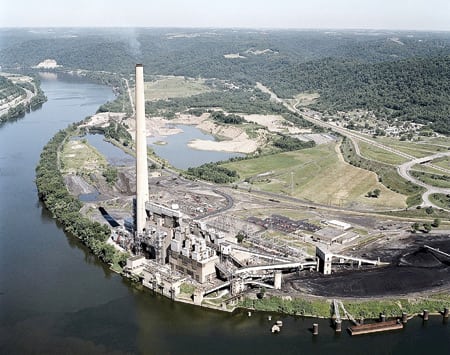
1. Host with the most. In 2004, FirstEnergy’s R.E. Burger Plant began operating, for demonstration purposes, a 50-MW (equivalent) version of Powerspan’s Electro-Catalytic Oxidation (ECO) multipollutant removal process. Courtesy: FirstEnergy
After successful pilot testing funded and hosted by FirstEnergy, in February 2004, Powerspan installed a 50-MW (equivalent) commercial demonstration unit (CDU) of its Electro-Catalytic Oxidation (ECO) process (Figure 3) at the Burger plant and began testing it as an integrated system. The CDU worked on an 110,000-scfm (standard cubic ft/min) gas slipstream from the ductwork of Unit 4 or 5, downstream of the plant’s existing electrostatic precipitator (Figure 4). The treated gas was returned to the ductwork just upstream of the stack.
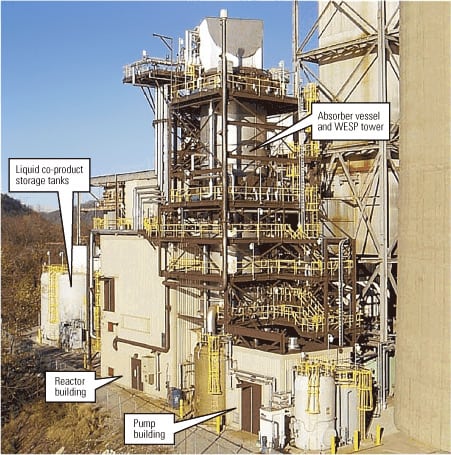
3. Proof of performance. In 2005 the ECO commercial demonstration unit was operated continuously for six months to confirm the design and reliability of the system. Although the demo ended two years ago, the ECO unit remains in service. Source: Powerspan
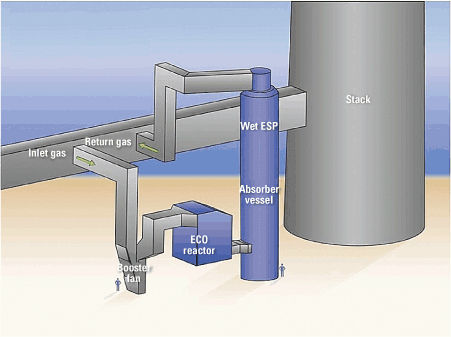
4. Hooked on gas. A 50-MW (equivalent) gas stream was taken from the stack gas, treated in the ECO system, and then returned to the ductwork just ahead of the stack. Source: Powerspan
A 180-day reliability run of the CDU that ended in September 2005 demonstrated that ECO meets all current performance requirements for NOx, SO2, and particulate control, and can remove 85% of the Hg in flue gas to boot. The table summarizes the results of the reliability run, during which the CDU was more than 98% available.
The demonstration project was funded by Powerspan, FirstEnergy, and the Ohio Coal Development Office of the Ohio Air Quality Development Authority (www.ohioairquality.org). In addition to the first two companies, the project team included the Siemens Power Generation subsidiary Wheelabrator Air Pollution Control Inc. (www.wapc.com), Fluor Power (www.fluor.com), and The Andersons Inc. (www.andersonsinc.com), which handled fertilizer co-product removal, marketing, and sales. The ECO CDU remains in service today.
It’s modular, so it’s scalable
Some might argue that the results of testing a 50-MW CDU are not representative of the performance of a full-size ECO process retrofitted to a plant 10 times larger. But because the system’s dielectric barrier discharge reactor and wet ESP are modular, and their performance is based on gas volumetric flow and the reaction chemistry, the ECO process is eminently scalable to any size required. Although the system’s ammonia scrubber is not modular, the technology for scaling that part of the process is well understood.
From the lab to the field
Powerspan is making the transition from being a pure technology developer to a commercial supplier. It recently announced the sale of its first utility-scale ECO system to—no surprise—FirstEnergy, which plans to install a single full-size unit to serve the combined flue gas of Burger’s 156-MW Unit 4 and 312-MW Unit 5. That certainly says something about FirstEnergy’s confidence in the process.
“We believe installing ECO will enhance the viability of the Burger Plant and give us more flexibility in our use of eastern coal,” said Richard R. Grigg, an executive vice president and the chief operating officer of FirstEnergy. “In addition, we believe that ECO provides a cost-effective method for meeting environmental regulations, including those of the CAIR and CAMR.”
Because FirstEnergy is planning to use selective noncatalytic reduction technology at R.E. Burger to remove NOx, the ECO unit it has ordered will not be equipped to handle that pollutant. Design engineering of the unit has already begun, and start-up is scheduled for the first quarter of 2011. The estimated cost of the unit is about $168 million—an apparent bargain, given today’s high and rising AQCS costs.
The ECO process is just as applicable to greenfield plants as to existing ones. This June, American Municipal Power-Ohio (AMP-Ohio) committed to use the process at its proposed AMP Generating Station, a 1,000-MW coal-fired project in Meigs County, Ohio. The selection was driven by the promise of CO2 capture by the recently announced ECO2 system, which is being designed to integrate easily with the ECO process (see box). Naturally, AMP-Ohio will be a partner in a planned program to test a pilot version of ECO2 at the Burger Plant.
Powerspan expects that by exploiting economies of scale, future ECO projects should be able to maintain their 10% to 20% installed-cost advantage over combinations of conventional, single-pollutant ACQS. As for operating costs, the company emphasizes that they depend on precise knowledge of specific plant variables, such as the level of NOx in the flue gas to be treated, the sulfur content of the coal being burned, the cost of ammonia reagent, and actual revenue from fertilizer sales. Because the system is so tightly integrated, the cost to remove individual pollutant-control components depends on how one chooses to distribute the system’s cost among the pollutants.
Nevertheless, Powerspan says it expects operating costs to be about 20% less than those of conventional technology solutions, even discounting the value of ECO’s ability to meet the new PM2.5 and Hg regulations. As for availability, an EPRI-commissioned study by Burns & McDonnell concluded the ECO equipment is at least as reliable as conventional equipment, predicting better than 99% availability.
